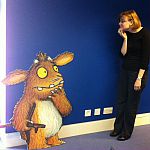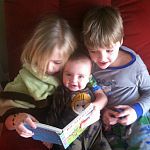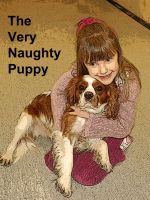Here is some interesting information about some of our recent and/or favourite projects.
If you are a parent and interested in our lab, consider also reading our what to expect page and completing our sign-up form to learn more!
Below are some summaries of a few of our recent and most favourite studies:
Again! Project
 Jessica Horst (right) meets the Gruffalo's Child (left) at Seven Stories in Newcastle
Jessica Horst (right) meets the Gruffalo's Child (left) at Seven Stories in Newcastle
The Again! Project is an initiative run by Durham County Council, in cooperation with Seven Stories in Newcastle. The inspiration for the project was the WORD Lab research demonstrating that reading the same stories again and again helps children learn new words (see below).
The Again! Project provides books and training to staff at local children's centres and nursery settings. The staff learn about the benefits of reading the same stories repeatedly and take this knowledge back to their children. Children between 2 and 3 years are read the sames stories again and again--and they love it! At some centres they are even promoting this kind of reading with een younger children. As of September 2014, 71 settings (26 children's centres and 45 nurseries) were participating, some for the third time. The response from the staff, children and parents has been outstanding. Many parents are reporting their children are more interested in reading books, talking about books and are even improving their concentration skills.
We are delighted to support the Again! Project and to know that our research is making a valuable difference to real children, particularly children for whom shared storybook reading is a new activity.
Goodnight Book
Williams & Horst (2014)
 Children sharing a bedtime story.
Children sharing a bedtime story.
We recently demonstrated that children learn more words from reading books before bedtime than before staying awake. In this study, 3-year-old children either heard the same story three times or three different stories--but everyone was exposed to the new words the same number of times. Half of the children regularly took naps and half no longer took afternoon naps. We read the stories and then children who still napped on a regular basis took their naps. We tested children's ability to learn the words from the stories right after the stories (baseline) and then again in the afternoon after the naps or the same amount of time awake, 24 hours later and again 1 week later.
Children who napped learned more words than children who did not nap. Like one of our previous studies, we found that children learned more words when they heard the same story read over and over again. Critically, children who heard different stories and napped learned 33% more words than children who heard different stories and did not nap. One week later, children who had not napped after the different stories still had not caught up to their peers in terms of word learning.
Overall, all of the children in the study did very well—reading is always good, at any age and any time. But, children who were learning something particularly difficult (new words from several stories) especially benefited from hearing the stories right before sleeping. In fact, these kids ended up learning the words as well as the children who had heard the same stories again and again, which we knew would be easier. We had a lot of fun running this study and we're really pleased to be able to tell parents something positive and motivating.
The journal article for this study is open access (anyone can download it). It was the most-viewed paper at the journal during the month when it was published. The article is part of a special research topic all about learning from books at Frontiers in Developmental Psychology.
The Right Thing at the Right Time
Axelsson, Churchley & Horst (2012)
 Our light-up tray in action
Our light-up tray in action
We recently explored how ostensive naming--being really obvious about what a name is refering to--helps children learn words. For this study, we used a special "light-up tray" (see picture on the left). For some children, the target (the new object we tried to teach a name for) was illuminated below by a special light. For some children, the non-targets (the other objects) were covered to help convey that they weren't the correct items. For some children both the targets were highlighted and the non-targets covered. Finally, in a control group the adult simply pointed to the target.
Overall, children who saw the targets lit-up learned the words significantly better than the other children. This is an important finding because it demonstrates that young children don't just pick-up the meanings of words but need particular reinforcement. Covering the non-targets along with lighting-up the target did help children to learn the words as well. Ideally, to help children learn words adults should point out both the key item to focus on as well as indicate what not to focus on.
This research was funded by a grant from the ESRC. The journal article is part of a special research topic at Frontiers in Developmental Psychology.
The Same Old Story
Horst, Parsons & Bryan (2011)
 Cover of one of our storybooks
Cover of one of our storybooks
Many parents have witnessed the phenomenon that children ask for the same story to be read again and again... and again and again. We recently asked if hearing the same story again and again helps children to learn words. Not surprisingly, the answer is yes. More suprisingly, however, is that when children heard the same stories repeatedly they learn the words a staggering 200% better than children who heard the same words the same number of times but by hearing different stories.
In this study, we visited children in their homes three times within one week. For children who heard the same stories, on each visit a story was read three times back-to-back (for example, a child might hear The Very Naughty Puppy three times in a row). For children who heard different stories, one each visit three different stories were read, but importantly, these had the same number of new words, which occured the same number of times.
Children who heard the same stories learned many more words than children who were read different stories even though everyone had heard the new words the exact same number of times. This suggests that children really do get a lot out of hearing the same stories again and again!
The journal article for this study is open access (anyone can download it). This paper was also summarized in a review article, which you can also download.
